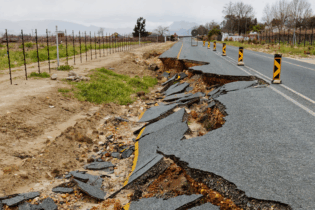The North West, where many roads have been left to disintegrate, has become the latest province to ask the SA National Roads Agency (Sanral) to take some of its road network off provincial books. Sanral will step in to try to limit the number of provincial roads that fall into disrepair. It has traditionally managed a national road network of 16 170km, but this could double to 35 000km.
Sanral road network manager Louw Kannemeyer says that 2 075km of roads in the Eastern Cape was passed to Sanral in April, increasing its network to 18 247km. This includes roads that improve access to the province from the Free State, as well as roads that intersect with or connect to the N2. Last month, North West premier Thandi Modise asked that 1 350km of its roads be incorporated into Sanral’s network. Premiers have to submit a formal request to the department of transport or Sanral before the incorporation can occur. Only the Eastern Cape and North West have done this so far. Kannemeyer says Sanral has been waiting since 1998 for some provinces to do this, but not all agree that it is the best route to take. If they do request it, it is envisaged that Sanral’s new 35 000km network will eventually be divided between a strategic network of 20 000km and a supporting primary network of 15 000km, Kannemeyer says. Road conditions for the sections that Sanral will incorporate vary, he says. In some provinces, as much as 50% of the roads are in poor to very poor condition, based on assessments by the provinces themselves. “Maintenance will be applied according to the best practice standards developed by Sanral on its existing network, which has a focus on preventive maintenance.” This includes cleaning drainage structures, sealing cracks, cutting grass and waterproofing the surface, he says. The investment will be funded from existing Sanral allocations received from national treasury for non-toll national roads. He says these allocations are expected to be adjusted to reflect the larger network. Disintegration of the provincial, and in some cases municipal roads, is becoming untenable. Their network also far exceeds what Sanral can look after. SA’s estimated road network comprises about 60 6978km of proclaimed roads and about 140 000km of unproclaimed roads, predominantly in rural areas. Just 2% are national roads. Moreover 80% of the roads are unpaved, according to national treasury’s most recent local government budget and expenditure review. Provinces that have a significant portion of their road network in a very poor state include KwaZulu-Natal (22%), Mpumalanga (15%), the Northern Cape (9%) and the Eastern Cape (7%). Lack of informationPart of the problem is the lack of adequate information about the state of the road network, which is supposed to be compiled by the transport department. Provinces do not know what condition their roads are in, making decisions about intervention and budgeting difficult. Both provinces and municipalities used to carry out annual studies using the visual condition index, but these have stopped, mainly because of a lack of technical capacity and budgets. An Automobile Association study from 2008 shows that the condition of SA’s roads dropped from an index level of 65 in 1998 to 46 in 2008. This indicates that the average quality of road is poor and requires “extensive work to salvage it”. In 2010, the Free State government was forced to deal with its crumbling road network after the province received claims worth R68,5m from motorists for pothole damage in just two years. The Free State has 6 370km of tarred and 22 179km of gravel road. It admits that the majority of the roads are in “a poor state and require urgent rehabilitation”. Budget shortfalls and a lack of skilled managers have hampered construction and maintenance. The province responded by launching an innovative approach to road construction when it issued 23 contracts for maintenance and repair work on a design, construct and finance basis. Because it didn’t have money to fund road construction immediately, it undertook to pay contractors annually, rather than monthly.
But its attempt to get things right went awry. Eighteen months after project work first began, roads have been abandoned by contractors who have not been paid by the province.
Leaders send financing off trackLeadership shuffles in the Free State government and the non-payment of contractors sent what could have been an excellent means of financing road construction off track. The contract also flouted national treasury rules for public-private partnerships. Since then, treasury has asked Sanral to ascertain whether the contracts were priced at the right level, in the belief that the province may have overpaid for them. In the meantime, road construction is at a standstill. The commercial and financial director of road builder Raubex, Francois Diedrechsen, says Free State authorities have had meetings with contractors over the past month to negotiate rates. Once a price has been agreed to, contractors will have to complete outstanding work before they are paid in full. Raubex has three contracts for which it is still waiting for final payment. One is complete. The process, says Diedrechsen, is slow and cumbersome, but “at least there is communication”. Other companies affected include Basil Read, WBHO and Sanyati, which was liquidated last week and was owed more than R60 million for work done. Of Raubex’s work with other provinces, Diedrechsen says tenders for projects are few and far between, despite the extent of the work that is sometimes desperately required at provincial level. “The red tape at provincial level feels insurmountable at times. The bottleneck at provincial and municipal level is about getting the work out. Tenders are a technical process that requires sophisticated financial and engineering expertise, which they simply do not have.” In provinces like Mpumalanga, industry has contributed to the state of disrepair. The constant traffic of trucks hauling coal between mines and power stations has been extremely detrimental. In Limpopo, just 30% of the road network is paved. Moreover, its geography has worked against it. The terrain, type of soil and weather conditions in parts of Limpopo like Vhembe and Bohlabela shorten the life span of roads in the area. The province says this makes it expensive to construct and maintain roads in mountainous areas. Most contractors agree that large municipalities are slightly more efficient than provinces. According to treasury, local government is responsible for about 54% of the total network. In metros, 80% of paved roads are in good and very good condition. For smaller municipalities, the SA Local Government Association wants government to develop a different funding model for road construction. But the focus on funding has drawn criticism from those who believe that human rather than financial resources are the cause of the problem. Allocating more provincial roads to Sanral will be a necessary first step. It is also the most cost-efficient solution. Costs will be limited to the appointment of project engineers in existing Sanral offices, Kannemeyer says. Source: bizcommunity







